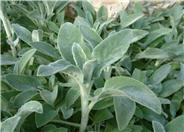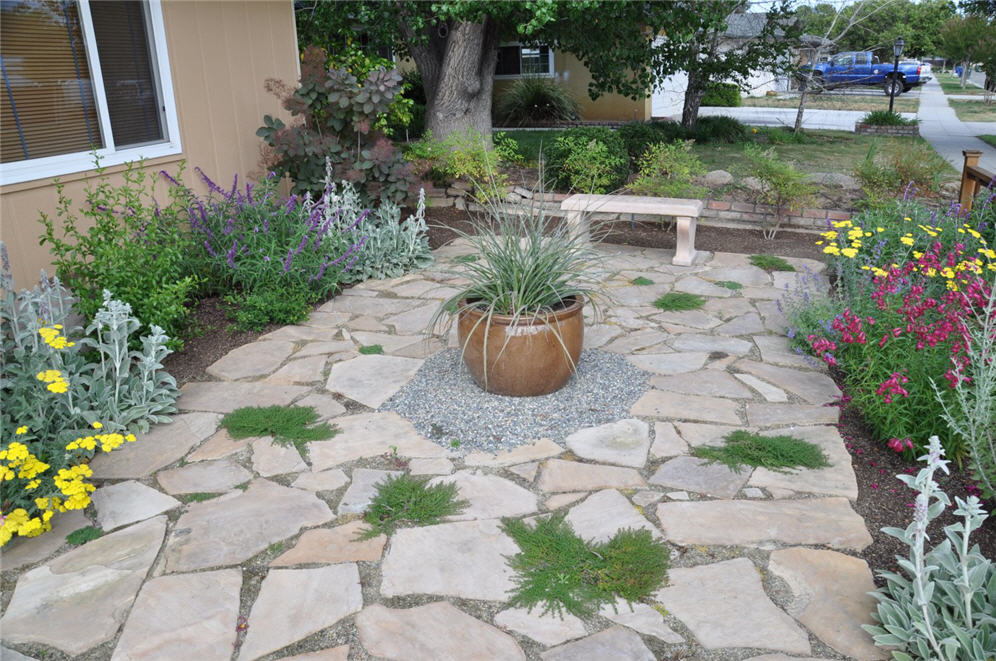
Common name:Moonshine Yarrow, Milfoil, Sneezewo
Botanical name:Achillea 'Moonshine'
Long, straight stems with pale yellow flowers are striking on the mats of green to grey-green leaves of this plant, which are flatter and less divided than those of the Achillea millefolium. This Yarrow propagates easily from rooted cuttings or divisions which should be performed in the early spring or fall. Following bloom, one should dead head the plant and divide the clumps when it appears crowded. Introduced by Alan Bloom in the 1950's.

Common name:Lamb's Ear
Botanical name:Stachys byzantina
This tiny shrub will grow less than 1' tall and has medium-size, greyish-green leaves with blue and lavender flowers that bloom in the spring. This shrub is grown more for its velvety leaves than the flowers. It is drought tolerant once it's established. Be careful not to overwater.

Common name:Mexican Bush Sage, Mexican Sage
Botanical name:Salvia leucantha
The Mexican Sage is a bushy shrub that grows 3'-4' tall and wide. It has hairy white stems, grey-green leaves and velvet-like purple flower spikes that bloom summer through fall. This shrub tolerates sun, light shade, low to moderate water, and is cold hardy to 15 degrees F. The Mexican Sage attracts hummingbirds. Be careful not to overwater.

Common name:Firebird Border Penstemon (red)
Botanical name:Penstemon 'Firebird'
Penstemon gloxiniodes 'Firebird' is perennial with spectacular red flowers in spring and fall. This dependable plant quickly reaches 2'-4' tall, with lance-shaped, dark green leaves on stems. Trumpet shaped flowers attract butterflies and hummingbirds. Plant in full sun in coastal areas but provide afternoon shade in warm inland areas. It has low watering needs but will do better with extra summer water in hot inland valleys. It need well draining soil. Penstemon should be replaced every 5 years.

Common name:Purple Smoke Tree
Botanical name:Cotinus coggygria 'Purpureus'
A deciduous shrub or small tree that grows up to 10' tall, the "Purpureus" is grown for its wispy, thread-like flower clusters in summer. Its green foliage turns a brilliant purple and then yellow to red in the fall. This shrub is a show stopper! It prefers full sun but will do better with afternoon shade in hot inland areas. This attractive shrub is drought tolerant once it's established.

Common name:Red Yucca
Botanical name:Hesperaloe parviflora
This spectacular succulent grows to 3'-4' tall and wide. Blue green leaves are strap-like, leathery, long, with white fraying fibers on the edges. During the summer, dark pink flowers are seen on red flower arching stalks. Hummingbirds love these flowers. This evergreen plant is drought tolerant once it's established but will appreciate extra water during the summer to promote blooms. Plant in full sun or light shade, with well draining soil. Deer like the foliage. This plant looks great in pots.

Common name:Moonshine Yarrow, Milfoil, Sneezewo
Botanical name:Achillea 'Moonshine'
Long, straight stems with pale yellow flowers are striking on the mats of green to grey-green leaves of this plant, which are flatter and less divided than those of the Achillea millefolium. This Yarrow propagates easily from rooted cuttings or divisions which should be performed in the early spring or fall. Following bloom, one should dead head the plant and divide the clumps when it appears crowded. Introduced by Alan Bloom in the 1950's.
| Designer: Terri Nichols | Peaceful Setting |
Photographer: GardenSoft |
Soils and Compost:
Practice grass-cycling by leaving short grass clippings on lawns after mowing, so that nutrients and organic matter are returned to the soil.
Water Saving Tip:
Apply as little fertilizer as possible.
If you use fertilizer make sure it stays on the landscape, and carefully water it in so there is NO runoff.
Integrated Pest Management:
Drip and other smart irrigation delivers water directly to roots, allowing no excess water for weeds.
